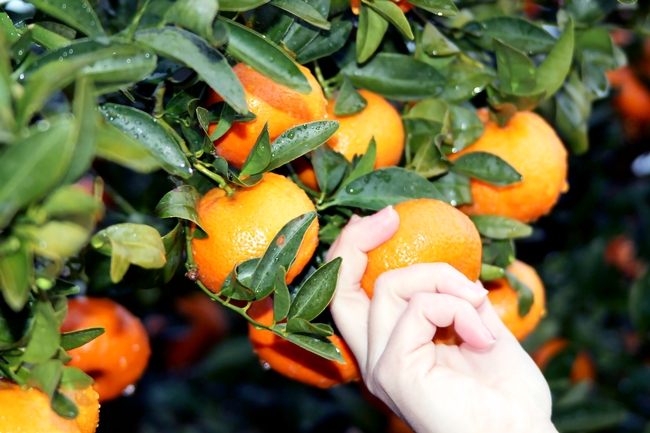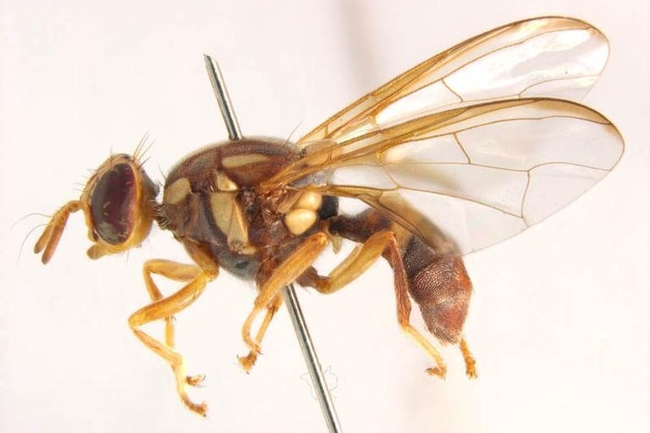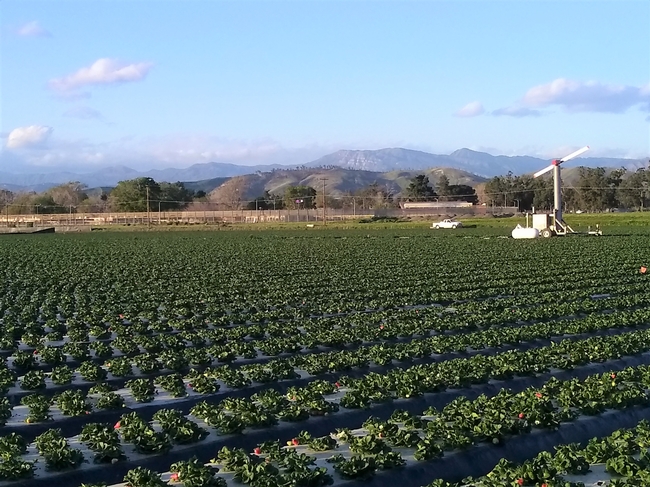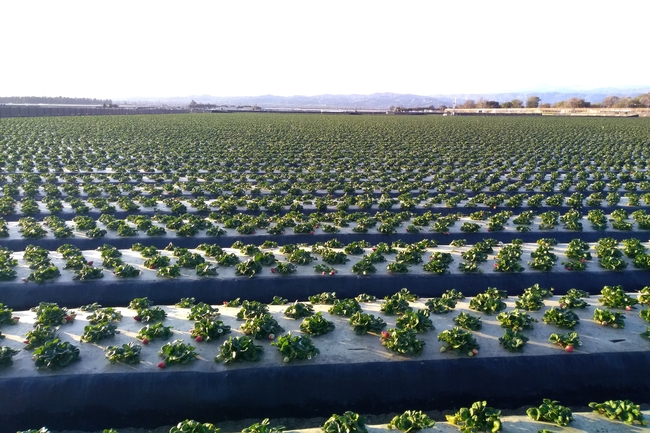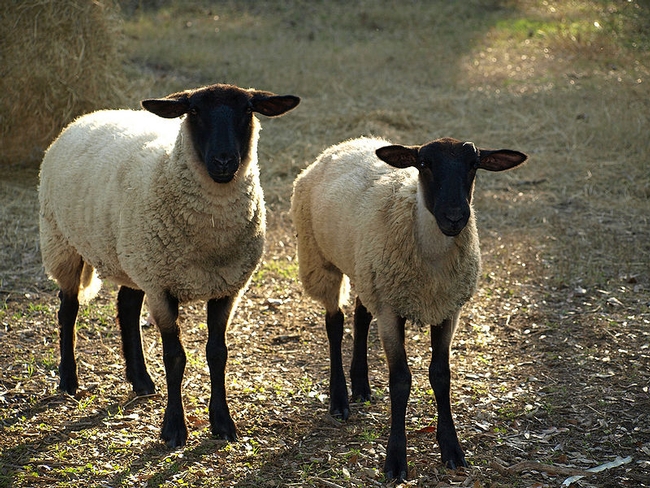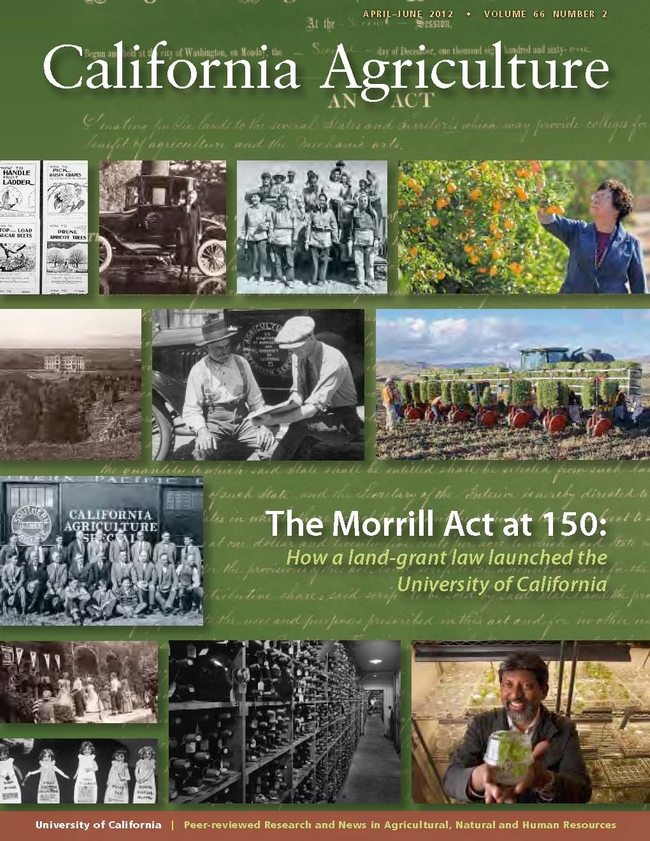Posts Tagged: Ventura County
First-ever Queensland fruit fly quarantine restricts moving homegrown produce
QFF quarantine in LA, Ventura counties among seven fruit fly quarantines statewide
Residents in multiple Southern California and Northern California counties should not move homegrown fruits and vegetables from their properties to help contain several species of fruit fly that can destroy crops and impact the livelihoods of local farmers.
With sharing and gifting of food integral to the holiday season, the California Department of Food and Agriculture is reminding people to heed the seven active fruit fly quarantines aimed at controlling the Mediterranean fruit fly, Oriental fruit fly, Tau fly and Queensland fruit fly. The links below describe quarantine zone boundaries:
- Mediterranean fruit fly: Los Angeles County, Leimert Park Area
- Oriental fruit fly: San Bernardino and Riverside Counties, Redlands and Yucaipa Areas
- Oriental fruit fly: Sacramento County, Rancho Cordova Area
- Oriental fruit fly: Contra Costa County, Brentwood Area
- Oriental fruit fly: Santa Clara County, Santa Clara Area
- Tau fly: Los Angeles County – Stevenson Ranch, Valencia, Santa Clarita Areas
- Queensland fruit fly: Ventura and Los Angeles Counties, Thousand Oaks Area
People within these zones should consume or process (i.e., juice, freeze or cook) their homegrown fruits and vegetables at the place of origin and not move them off their property. Uneaten produce should be double-bagged in plastic bags and disposed of in the landfill bin – not compost or green waste.
Queensland fruit fly threatens California citrus, other crops
The Queensland fruit fly (Bactrocera tryoni) quarantine is the first of its kind in the U.S. Although QFF was first seen in California in 1985, the recent detection of two adult males triggered the unprecedented quarantine action by USDA's Animal and Plant Health Inspection Service and CDFA.
“This pest has earned a bad reputation for wreaking havoc on fruit production in Australia, where it is native,” said Hamutahl Cohen, University of California Cooperative Extension entomology advisor for Ventura County. “Adult flies lay their eggs in fruit, and the eggs hatch into larvae that then feed on the fruit, causing damage.”
And while females of other fruit fly species live for only two or three months, QFF females are unique in that they can live up to a year, according to Cohen.
“Once QFF populations take root, they're challenging to manage because females can each lay up to 100 eggs per day,” Cohen said.
In addition to being highly adaptable to a variety of environmental conditions, QFF has more than 170 host plants – including a wide range of California commodities such as citrus, grape, strawberry, fig, avocado, apricot, peach, cherry, nectarine, plum, pear, apple, tomato and sweet pepper.
The threat to citrus is especially concerning, as Southern California growers continue to grapple with the specter of spreading huanglongbing (HLB) disease, which kills citrus trees. Cohen said residents of citrus-growing regions can do their part to help their neighbors and local economy by respecting quarantine restrictions.
“Growers are already dealing with other invasive species like Asian citrus psyllid [vector of HLB pathogen], so we as homeowners need to prevent the spread of fruit flies to reduce the burden on them,” she explained.
While a spike this year in the detections of multiple fruit fly species was likely caused by a host of factors, Cohen speculates that increased post-pandemic travel is helping to move the flies. And with holiday travel in full swing, she said it's important to practice “Don't Pack a Pest” principles.
“Invasive species often hitchhike on fruits and vegetables brought into California by travelers – that's why we often first find invasive species in urban and suburban backyards, and not on farms,” Cohen said. “Travelers entering the U.S. can visit dontpackapest.com to learn about which products they can and cannot bring back with them.”
To report a suspected infestation of fruit fly larvae in homegrown produce, call the CDFA pest hotline at 1-800-491-1899. Growers with questions and concerns are urged to contact their local agricultural commissioner's office.
Agricultural research and education center moving to new site in Ventura County
UC Hansen Research and Extension Center to expand capacity at Camarillo location
The University of California Hansen Agricultural Research and Extension Center – the site of popular school field trips, 4-H programs, a UC Master Gardener demonstration garden, and numerous research trials on crops and landscape plants – is moving to a new location on the west side of Camarillo. The center was established through an endowment bequeathed to the UC by Saticoy farmer Thelma Hansen, who sought to support university research and extension activities benefiting Ventura County.
For the past 25 years, Hansen REC has been located on the historic Faulkner Farm in Santa Paula. At 27 acres, Hansen REC was the smallest of the nine RECs across the state operated by UC Agriculture and Natural Resources; in 2019, UC ANR leadership decided a larger property was needed to expand the center's capacity. The Faulkner Farm was sold in March 2021, but a portion was leased back to the UC to sustain its programs until a new location was identified.
In December 2022, the UC acquired a 114-acre farm property in Camarillo to serve as Hansen REC's new home. Moving structures and equipment from Faulkner Farm will take place over the next six months. Public programs at the new location are on hold until seismic retrofitting and other building upgrades are completed. A new research and educational facility also will be built, with an estimated opening date in 2027 or 2028.
“Our planning committee looked for a site on the Oxnard Plain that is representative of the coastal agriculture environment and conducive to research on Ventura County's high-value crops, such as strawberries,” said Annemiek Schilder, Hansen REC director. “We also sought a location with diverse soil types, access to sufficient irrigation water, and a low risk of flooding – and we're pleased that this Camarillo property meets most of our search criteria.”
Of the approximately 104 cultivable acres, 28 are certified organic, which will allow researchers to study organic as well as conventional crop production methods, Schilder noted. She said another bonus of the new location is its proximity to California State University, Channel Islands and the Rodale Institute California Organic Center, which are both potential partners for future research and a student organic farm on site.
Initial plans for the new Hansen REC facility include offices, conference rooms, laboratories, greenhouses, a demonstration kitchen, and indoor and outdoor education areas. The center will aim to be water-efficient and energy-neutral, relying on solar panels for much of its energy usage. The UC Cooperative Extension Office in Ventura is also slated to move to the new facility.
“We fully expect Hansen REC to become a vibrant research and education hub that provides science-based solutions and is responsive to the needs of agricultural, rural and urban communities and the environment in Ventura County,” said Glenda Humiston, UC vice president for agriculture and natural resources. “We're excited to expand current programming while bringing in new educational opportunities, such as the UC Master Food Preserver and Master Beekeeper programs.”
Ojai 4-H member earns enough for new wheelchair by raising a sheep
4-H, offered in all California counties by UC Cooperative Extension, engages youth ages 5 to 19 in reaching their fullest potential. Club and after-school programs are designed to provide knowledge, expertise and skills that will help youth develop into responsible, self-directed, and productive people. 4-H encourages family involvement.
The Ventura County Star's heart-warming story traces Demisu's journey from his native Ethiopia to a ranch in rural Upper Ojai. One of 10 children, three adopted from the west African nation, Demisu has triplegia, the use of only his right arm. The rocky and uneven terrain at the family's ranch made it difficult for Demisu to get around, so he decided to raise funds for a heavy-duty wheelchair that he can operate with one hand. The cost is $6,000.
Demisu raised a 113-pound lamb, and sold it for $75 a pound to the Wood-Claeyssens Foundation. At market, sheep are typically valued at about $1 to $2 per pound, according to Sheep101.com. Bidding for Demisu's sheep went through the roof when bidders learned he would be using the money for the new, custom wheelchair.
Many agricultural issues can be resolved with UC Cooperative Extension
There are many issues facing Ventura County farmers that UC Cooperative Extension is working to resolve, according to presentations yesterday at an event celebrating UCCE's first 100 years of science and service. The event was covered by reporter Carol Lawrence of the Ventura County Star.
At the event, UCCE advisors talked about the status of ag industry in Ventura County, where total farm production is nearly $2 billion annually. Strawberries, the county's leading crop since the early 2000s, are valued at $690 million. However, production is threatened by dwindling water supplies.
"We can't avoid this topic," said Oleg Daugovish, UCCE advisor.
UCCE advisor Ben Faber also discussed the water situation. The average annual rainfall in Oxnard was 17 inches between 2003 and 2008.
"We're living in an environment that rarely sees the average rainfall," Faber said.
Faber's work includes showing growers how using too much or too little water is more likely to cause plant disease and demonstrating new ways of measuring the water content in soil, the article said. One solution to water woes is using recycled water in nurseries. The practice saves 14 to 42 percent of water.
UCCE advisor Jim Downer talked about the movement of exotic pests that are a potential challenge to agriculture. California is particularly vulnerable to these pests because of its vast and varying geography and climate, he said.

Ventura County's top 10 ag commodities were on dispaly in a Model T truck at the UC Cooperative Extension Celebration of Science and Service.
Lincoln’s visionary land-grant law launched UC 150 years ago
In 1862, in a nation torn by secession and Civil War, President Abraham Lincoln signed a visionary law that laid the cornerstone of public higher education in California and nationwide.
The Morrill Land-Grant College Act of 1862 gave federal public lands to states, allotting 30,000 acres for each senator and representative. States were encouraged to sell these “land grants” to raise money for new public universities that would educate Americans in agriculture, science and mechanical arts.
California legislators took the federal government up on its offer in 1864, and the first buildings of the University of California were completed in 1868 on the banks of Strawberry Creek, in the Berkeley hills.
In honor of the Morrill Act’s sesquicentennial, the April-June 2012 issue of California Agriculture journal includes extensive special coverage of how the 150-year-old land-grant law launched one of the world’s greatest systems of public higher education — the University of California.
“The nationwide university access the Morrill Act provided was certainly a game-changer in social mobility and economic prosperity,” UC President Mark G. Yudof wrote in California Agriculture. “Just as important was the Act’s intention to apply scientific research to farming methods and resources stewardship.”
California Agriculture’s special coverage of the Morrill Act anniversary includes an editorial by Yudof; an essay by Rose Hayden-Smith, UC Cooperative Extension advisor in Ventura County and historian; and a four-page photo gallery of rare and historic images. The entire April-June 2012 issue of California Agriculture can be viewed online at http://californiaagriculture.ucanr.edu.
In subsequent years, UC developed comprehensive statewide facilities that offered research, teaching and extension in agricultural, natural and human resources. The University Farm, established in Davis in 1906 as a teaching farm for UC Berkeley students, would later become UC Davis. The Citrus Experiment Station, founded in Riverside in 1907 to support California’s developing citrus industry, would become UC Riverside. And UC Cooperative Extension, established in 1914 as a federal, state and local partnership, works closely with the Agricultural Experiment Station to connect research with Californians in every county.
In her California Agriculture essay, Hayden-Smith describes the critical role that UC played in national wartime efforts.
“The importance of scientific agriculture and the role of land-grant institutions in promoting agricultural productivity were highlighted during World War I, when agricultural production and food security were viewed as vital to national security and victory ‘over there’,” wrote Hayden-Smith, a 4-H youth, family and community development advisor. UC provided instrumental support for undertakings such as victory gardens and school gardens, the Women’s Land Army, the Emergency Federal Labor Project, food conservation projects and new agricultural land settlements. In turn, these projects helped to build UC.
After World War II, the GI Bill of Rights spurred tremendous growth in college enrollment and further expansion of the University of California system, which now includes 10 campuses and generates some $46 billion in economic activity annually.
“The challenges we face together are far more complex than those California farmers faced in the 19th century,” Yudof wrote in California Agriculture. “Today we deal with issues like climate change, exotic invasive pests, food security, nutrition and childhood obesity, to name a few…True to the Morrill Act’s philosophy of melding science and agriculture, UC brings to the table the most visionary, industry-transformative research methods.”
Also in the April-June 2012 issue of California Agriculture:
Conservation tillage reduces water usage (research): UC researchers demonstrate that reducing or even eliminating tractor passes in Central Valley crop rotations — while maintaining crop residues on the soil surface — can significantly reduce the evaporation of irrigation water during typical growing seasons. Such methods, called conservation tillage, are gaining wider acceptance in California; a news story in the current California Agriculture notes that conservation tillage was used on more than 344,000 acres in the Central Valley in 2010. Additional research in 2011 showed that yields in cotton and tomato fields using conservation tillage were the same as in adjacent plots cultivated with conventional tillage.
Biotech strategies for fruit and nuts (research): A survey of major crop problems in California’s top 10 fruit and nut crops found that over the past 10 years little biotechnology research was directed toward these identified concerns. Likewise, the number of field permits issued for testing genetically engineered plants in California did not generally coincide with the major crop problems identified. The study found that citrus and grape are the focus of most current genetic engineering research and field permits in fruits, and walnut, rather than the more widely planted almond, is the focus among nut crops. The authors propose that transgrafting — the grafting of conventional scions onto genetically engineered rootstock — is a promising approach, but could result in regulatory questions for exported crops.
New quality index for kiwifruit (research): UC postharvest researchers propose that dry matter content, coupled with acidity measurements, are a better quality index for kiwifruit than soluble solids concentrations, which are currently used by most kiwifruit-producing countries. Consumer tests in 1999 and 2008 indicated that dry matter and ripe titratable acidity were related to in-store acceptance of kiwifruit. Likewise, a six-year survey of California kiwifruit harvested from vineyards in the Central Valley found that dry matter levels were highly variable among vineyards and seasons, but acidity levels varied more among seasons than between vineyards.
Sierra Nevada fire prevention (news): The Sierra Nevada Adaptive Management Project (SNAMP) — a unique collaboration between the U.S. Forest Service, UC and state and federal agencies — is developing methods to improve forest health and diminish fire danger in California via strategic fuel reduction treatments. As described in a California Agriculture news story, SNAMP research projects are focusing on forest health, public participation, water quality, ecosystem mapping, and the California spotted owl and Pacific fisher (http://snamp.cnr.berkeley.edu).
California Agriculture is the University of California’s peer-reviewed journal of research in agricultural, natural and human resources. For a free subscription, go to: http://californiaagriculture.ucanr.edu, or write to calag@ucdavis.edu.

